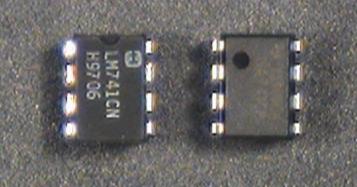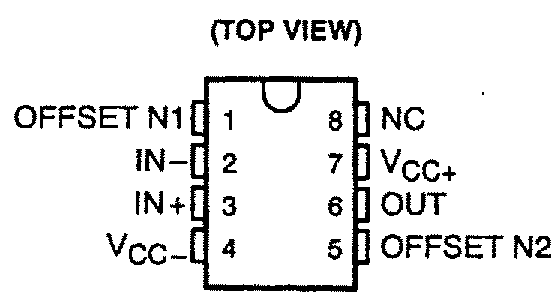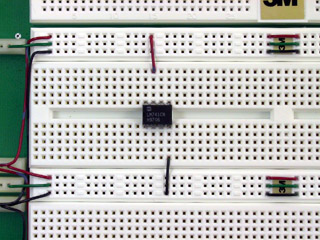The 741 operational amplifier, or op-amp, comes in an 8-pin dual inline package (DIP) which looks like this


![\includegraphics[scale=0.640000]{opamps/cktsym.ps}](img232.png)
In order to function, the op-amp must be connected to an external
power supply.
Since we want to produce both positive and negative output
voltages, we need both positive and negative voltages
for the power supply.
These are labeled ![]() and
and ![]() on the diagram.
For a 741, the nominal values are
on the diagram.
For a 741, the nominal values are ![]() =15 V and
=15 V and
![]() =15 V.
=15 V.
To avoid clutter, we won't show the power supply terminals (pins 4 and 7) on any of the subsequent circuit diagrams. However, they must be connected or your amplifier will not operate.
Note that there is no ground terminal on the op-amp. The zero reference point is established by the external circuit and is not important to the op-amp itself.
 | |||
Step 1: |
If you have not already done so, wire the bus strips on
your breadboard
(as described in the
Before Lab
section)
to provide positive power, negative power
and ground buses.
 | ||
Step 2: |
Plug an op-amp into the breadboard so that it straddles the gap
between the top and bottom sections of the socket strip.
If you have wired the power buses as suggested above, Pin 1 should
be to the left.

 | ||
Step 3: |
Connect Pin 4 (
 | ||
Step 4: |
Set the
METER SELECTOR
on the power supply to
+20V.
With the power supply disconnected from the breadboard,
turn on the supply and adjust the left-hand voltage control
until the meter reads 15 volts.
 | ||
Step 5: |
Turn off the supply and connect the supply to the breadboard with banana plug patch cables. Connect the 0 to -20V terminal (black) to the black banana jack on your breadboard, the 0 to +20V terminal (red) to the red breadboard banana jack, and the COMMON terminal (light blue) to the green breadboard banana jack. Note that none of the power supply output terminals are connected to ground. If we want the power supply zero volt reference connected to ground, we must make the connection ourselves. |
 | |||
Step 1: |
With the power turned off,
wire the following circuit.
Note that this is a 1000:1 voltage divider, so that a 1 V
signal at ![\includegraphics[scale=0.650000]{opamps/open_loop.ps}](img233.png)
 | ||
Step 2: |
Set the function generator to produce a 2 V p-p,
20 Hz sine wave.
 | ||
Step 3: |
Connect the function generator output to  | ||
Step 4: |
You should see a badly distorted
(clipped)
waveform at  | ||
Step 5: |
Pull out the
DC OFFSET
control on the function generator and adjust it until the
waveform is roughly a symmetrical square wave.
 | ||
Step 6: |
Note the positive and negative peak values of  | ||
Step 7: |
Connect a 100 | ||
Step 8: |
Remove the 100 | ||
Step 9: |
Set the function generator to produce a 1 kHz sine wave.
Pull out the
AMPL
knob to engage the 20 dB attenuator.
Adjust the
AMPL
and
DC OFFSET
controls until the op-amp output is a 10 V p-p
unclipped sine wave.
Measure the amplitude of the function generator output.
 | ||
Question 1: |
Based on your measurements in the previous step,
what is the open loop gain of the op-amp?
Is it consistent with the specifications in the data sheet?
 | ||
Step 10: |
Push the
DC OFFSET
control on the function generator back in.
 | ||
Remark: |
We have just seen a number of the shortcomings of a real (as opposed to an ideal) operational amplifier: clipping, which limits the maximum amplitude of the output; slew-rate limiting, which limits the maximum slope of the output; and offset, which gives a non-zero output for zero input. When we reduce the overall gain with feedback, some of these (e.g. offset) are reduced significantly, and we get an output which is a faithful reproduction of the input. However, other limits (such as maximum output level) must be respected for this fidelity to remain. |